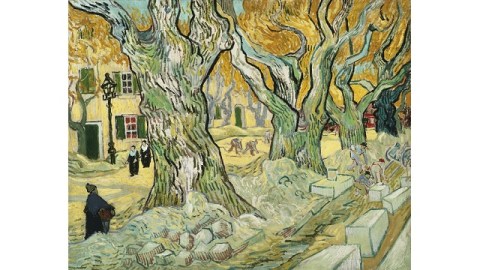Can Art Cure Alzheimer’s Disease?

If art can help us hold onto memories, can it help us when we lose them to aging or disease? In Creative Aging, which runs through November 30, 2012 at The Phillips Collection, Washington, DC, health experts and museum experts join forces to help those suffering from memory impairment, especially that related to Alzheimer’s Disease, and other physical challenges. Part of November’s National Arts and Health Month, Creative Aging uses the Phillips’ amazing art collection to stimulate the subjects’ minds and engage them in a dialogue with the art and each other. The thoughts, feelings, and memories stirred up, as well as the art they create, are unforgettable.
Building upon the idea that stimulating the mind can arrest or perhaps even reverse the cognitive effects of aging, The Phillips Collection partnered with Iona’s Wellness & Arts Center to develop an arts-based curriculum involving not just discussion of the art, but also hands-on art-making to increase the interactivity and stimulation. The non-verbal nature of visual art allows individuals suffering from verbal difficulties to express emotions in a different, but equally satisfying way. Subjects viewed art from The Phillips Collection that gave them multiple approaches, ranging from the more abstract, Color Field art of Morris Louis to the more realist work of John Sloan.
Somewhere between Louis and Sloan lies Vincent van Gogh, whose 1889 painting The Road Menders (shown above) became a topic of discussion and inspiration. Joan B. Habib, one of the individuals in the study, fell in love with The Road Menders. “I think van Gogh is very special,” Habib remarked. “I just love his work.…I love the whole concept of the trees. Trees, trees, and trees are lining the streets. And the colors are so fascinating. The reds and oranges just hold it all together.” Habib reproduced The Road Menders as a watercolor painting, exploring Van Gogh’s approach to color and texture in an intense, hands-on experience. The results are remarkable, but even more remarkable is the end result of mending mental processes that disease and/or years have curtailed. Creative Aging builds a road back to consciousness for these people and restores both dignity and humanity.
I was also taken with how the program used Edward Hopper’s 1926 painting Sunday, a typical “Only the Lonely” Hopper-esque image of solitude. Where others might read ambiguity, a spark ignited in the mind of Sidney, another participant. “What jumped out at me first was the man sitting down alone trying to make up his mind,” Sidney responded. “The question is what will he do next?” In addition to this verbal conclusion, Sidney created his own artistic response in the art therapy studio. The magic of Creative Aging is in these leaps and the positivity they generate. “The fellow is sitting down and I am assuming he is going to get up,” Sidney said in explanation of his visual response to Sunday. Not everyone assumes Hopper’s figures will ever rise, but these people assume he will because they assume they will.
Creative Aging isn’t alone in pursuing this line of therapy. Dr. Jordan J.N. Tang of the Oklahoma Medical Research Foundation recently presented a lecture titled “Fighting Alzheimer’s Disease with Art and Science” at the Oklahoma City Museum of Art. “It is important that art outreach programs like the one at OKCMOA bring artistic activities to people suffering from the disease,” Tang stresses. “Such creative activities enrich their lives and help to ease emotional strain from the disease.” This use of art as therapy saves not just minds, but souls in torment as memories and lives slip from their mental grasp.
As someone who has a family history of Alzheimer’s Disease, projects like Creative Aging seem almost too good to be true. I remember watching helplessly as my grandfather struggled not just with the loss of his memory, but also with the frustration over the loss of his personhood. The testimonials of those who participated made me smile, and hope. “When I create I don’t think,” Dorothy Tucker exuded. “I’m into what I am making not into anything around me.” When thinking in words gets too hard, art can always help us feel and “think” in pictures. But the most heartening testimonial came from Ike Hunter, who simply said that “It let me work from my heart.” Creative Aging works from the heart and for the heart while rescuing the mind.
[Image:Vincent van Gogh (1853-1890). The Road Menders, 1889. Oil on canvas; 29 x 361/2 in. The Phillips Collection, Washington D.C. Acquired 1949.]
[Many thanks to The Phillips Collection, Washington, DC, for providing me with the image above and other press materials related to the exhibition Creative Aging, which runs through November 30, 2012.]





